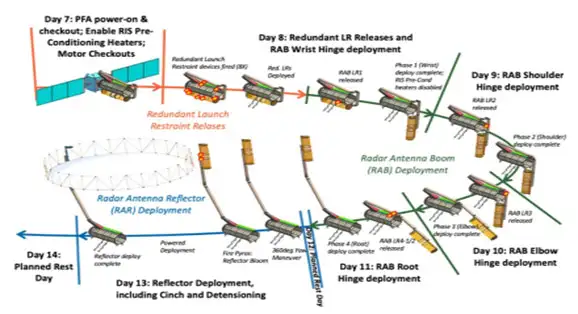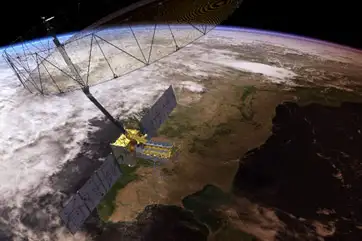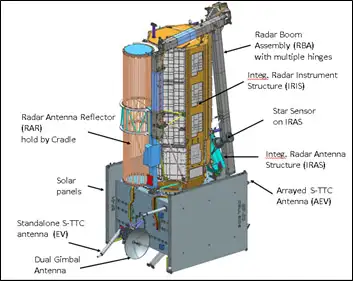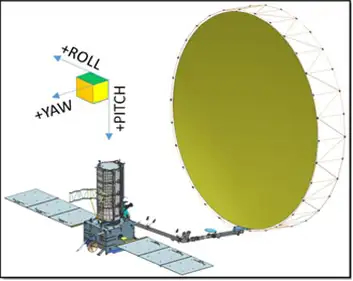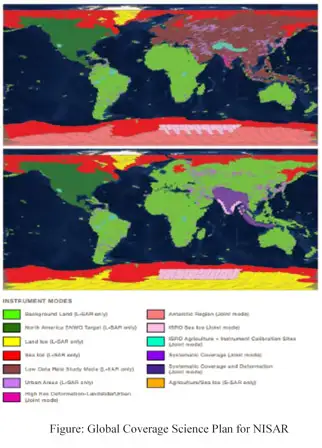NASA-ISRO SAR (NISAR) is a Low Earth Orbit (LEO) observatory being jointly developed by NASA and ISRO. NISAR will map the entire globe in 12 days and provide spatially and temporally consistent data for understanding changes in Earth’s ecosystems, ice mass, vegetation biomass, sea level rise, ground water and natural hazards including earthquakes, tsunamis, volcanoes and landslides. NISAR. It carries L and S dual band Synthetic Aperture Radar (SAR), which operates with Sweep SAR technique to achieve large swath with high resolution data. The SAR payloads mounted on Integrated Radar Instrument Structure (IRIS) and the spacecraft bus are together called an observatory. Jet Propulsion Laboratories and ISRO are realizing the observatory which shall not only meet the respective national needs but also will feed the science community with data encouraging studies related to surface deformation measurements through repeat-pass InSAR technique.
More Details
This flagship partnership would have major contributions from both agencies. NASA is responsible for providing the L-Band SAR payload system in which the ISRO supplied S-Band SAR payload and both these SAR systems will make use of a large size (about 12m diameter) common unfurl able reflector antenna . In addition, NASA would provide engineering payloads for the mission, including a Payload Data Subsystem, High-rate Science Downlink System, GPS receivers and a Solid State Recorder.
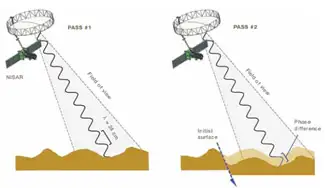
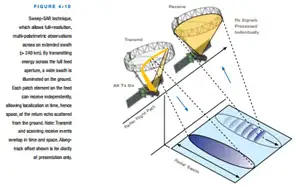
This would be the first dual frequency radar imaging mission in L-Band & S-Band using an advanced Sweep SAR technique to provide L & S band space-borne SAR data with high repeat cycle, high resolution, and larger swath, with capability of full-polar metric and interferometric modes of operation. It will provide a means of disentangling and clarifying spatially and temporally complex phenomena, ranging from ecosystem disturbances, to ice sheet collapse and natural hazards including earthquakes, tsunamis, volcanoes, and landslide This is expected to provide impetus to the fast maturing microwave remote sensing applications in geosciences. The precision interferometric orbits of the mission will enable in mapping few millimetres of deformations in the land surface. The selection of lower frequency bands will cater to the need for better characterization of vegetation, which is vital for global carbon stock estimation and monitoring of carbon fluxes from vegetation. Similarly, the selection of L- and S-band frequencies will enable characterizing targets beneath tree canopy and sub-surface features due to differential penetration of the signals in two frequency NISAR studying concepts for a Synthetic Aperture Radar mission is to determine Earth change in three disciplines: ecosystems (vegetation and the carbon cycle), deformation (solid Earth studies), and cryosphere sciences (primarily as related to climatic drivers and effects on sea level NISAR will acquire data over the Indian Coasts and monitor annual changes in the bathymetry along the deltaic regions. The shoreline and the erosion accretion also will be monitored. The NISAR mission will observe sea ice characteristics over the seas surrounding India’s Antarctic polar stations, can be used to detect the marine oil spill and disseminate the spill location during accidental oil seepage for preventive measures.
The NISAR observatory carries a 12m wide deployable mesh reflector mounted onto a deployable 9m boom developed by JPL which shall be used by both-JPL-NASA developed L-Band SAR payload system and ISRO developed S-Band SAR payload. The IRIS hosts the S-SAR and L-SAR tiles along with their electronics and data handling systems. The spacecraft incorporates all the attitude and orbit control elements, power systems, thermal management system. JPL also will provide the LSAR Data Handling system, High-rate Science data Downlink System, GPS receivers and a Solid State Recorder. ISRO is responsible for providing the SSAR data handling system, High rate downlink system, spacecraft bus systems, the GSLV launch system and Mission Operations Related Services. A perfect blend of two cultures and a creation by two sets of craftsmen is what NISAR is.
NISAR is being developed in three different phases as indicated below. The SIT-2 phase during which the SAR payloads and the Engineering Systems shall be independently developed in their respective soils. SIT-3 phase is when the SAR payload along with other related systems will get integrated to the Radar Instrument Structure and tested at JPL. Parallel activities of the spacecraft systems realization and testing is carried out at ISRO. The subsequent activities of integrating IRIS with the spacecraft and evaluating it as observatory is carried out at ISRO. This phase is called the SIT-4 phase which is the on-going phase now. The IRIS is ready to be shipped from JPL and spacecraft is getting ready to receive its counterpart. The SIT-4 testing phase is going to be very elaborate and critical as the performance evaluation of the entire observatory is planned during this phase. The NISAR observatory shall be launched from Indian Soil in the first quarter of year 2024 and the science community is surely to benefit from the data generated.
MISSION PHASE
LAUNCH PHASE
The NISAR Observatory will be launched from Satish Dhawan Space Centre(SDSC) SHAR, Sriharikota on the southeast coast of the Indian peninsula, on the GSLV expendable launch vehicle contributed by ISRO. The target launch readiness date is January 2024. The launch sequence encompasses the time interval that takes the observatory from the ground, encapsulated in the launch vehicle fairing, to after separation, and ends with the completion of solar array deployment and the observatory in an Earth-pointed attitude and in two-way communication with the ground. The launch sequence is a critical event.
COMMISSIONING PHASE
The first 90 days after launch will be dedicated to commissioning, or in-orbit checkout (IOC), the objective of which is to prepare the observatory for science operations. Commissioning is divided into sub-phases of initial checkout (ISRO engineering systems and JPL engineering payload checkout), spacecraft checkout and instrument checkout. Philosophically, the sub-phases are designed as a step-by-step build up in capability to full observatory operations, beginning with the physical deployment of all deployable parts (notably the boom and radar antenna, but not including the solar arrays which are deployed during launch phase), checking out the engineering systems, turning on the radars and testing them independently and then conducting joint tests with both radars operating.
SCIENCE OPERATIONS PHASE
The science operations phase begins at the end of commissioning and extends for three years and contains all data collection required to achieve the L1 science objectives. During this phase, the science orbit will be maintained via regular maneuvers, scheduled to avoid or minimize conflicts with science observations. Extensive calibration and validation (CalVal) activities will take place throughout the first 5 months, with yearly updates of 1-month duration. The observation plan for both L- and S-band instruments, along with engineering activities (e.g., maneuvers, parameter updates, etc.), will be generated pre-launch via frequent coordination between JPL and ISRO. This plan is called the reference mission; the science observations alone within that reference mission is called the reference observation plan (ROP). The schedule of science observations will be driven by a variety of inputs, including L- and S-band target maps, radar mode tables, and spacecraft and ground-station constraints and capabilities. This schedule will be determined by JPL’s mission planning team, and the project will endeavour to fly the reference mission, which includes these science observations exactly as planned pre-launch (accommodating for small timing changes based on the actual orbit).
